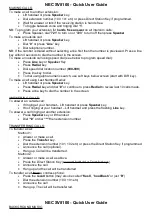
Production Data
WM9090
w
PD, November 2010, Rev 4.1
37
CONTROL WRITE SEQUENCER
The Control Write Sequencer is a programmable unit that forms part of the WM9090 control interface
logic. It provides the ability to perform a sequence of register write operations with the minimum of
demands on the host processor - the sequence may be initiated by a single operation from the host
processor and then left to execute independently.
Default sequences for Start-Up of each output driver and Shut-Down are provided (see “Default
Sequences” section). It is recommended that these default sequences are used unless changes
become necessary.
When a sequence is initiated, the sequencer performs a series of pre-defined register writes. The
host processor informs the sequencer of the start index of the required sequence within the
sequencer’s memory. At each step of the sequence, the contents of the selected register fields are
read from the sequencer’s memory and copied into the WM9090 control registers. This continues
sequentially through the sequencer’s memory until an “End of Sequence” bit is encountered; at this
point, the sequencer stops and an Interrupt status flag is asserted. For cases where the timing of the
write sequence is important, a programmable delay can be set for specific steps within the sequence.
Note that the Control Write Sequencer’s internal clock is derived from the internal clock CLK_SYS
which must be enabled by setting OSC_ENA (see “Clocking Control”). The clock division from
CLK_SYS is handled transparently by the WM9090 without user intervention.
INITIATING A SEQUENCE
The Register fields associated with running the Control Write Sequencer are described in Table 19.
Note that the operation of the Control Write Sequencer also requires the internal clock CLK_SYS to
be enabled via the OSC_ENA control bit (see “Clocking Control”).
The Write Sequencer is enabled by setting the WSEQ_ENA bit. The start index of the required
sequence must be written to the WSEQ_START_INDEX field. Setting the WSEQ_START bit initiates
the sequencer at the given start index.
The Write Sequencer can be interrupted by writing a logic 1 to the WSEQ_ABORT bit.
The current status of the Write Sequencer can be read using two further register fields - when the
WSEQ_BUSY bit is asserted, this indicates that the Write Sequencer is busy. Note that, whilst the
Control Write Sequencer is running a sequence (indicated by the WSEQ_BUSY bit), normal
read/write operations to the Control Registers cannot be supported. The index of the current step in
the Write Sequencer can be read from the WSEQ_CURRENT_INDEX field; this is an indicator of the
sequencer’s progress. On completion of a sequence, this field holds the index of the last step within
the last commanded sequence.
















































